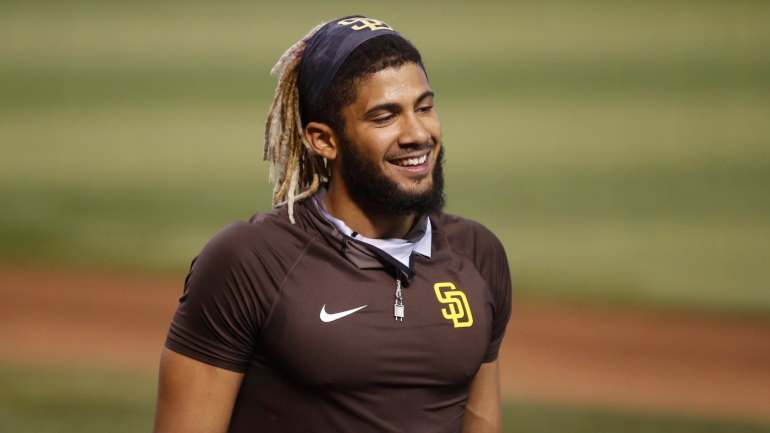
Spring training in Major League Baseball is fast approaching and that means we're creeping up on extension season. Historically, teams get down to business locking up their best players in February and March. There were 33 contract extensions signed during the 2019 calendar year and 20 of the 33 were signed in February and March. Extension season is coming soon.
With that in mind, let's look at the top extension candidates heading into the 2021 season. We have to apply some level of subjectivity here. For example, yes, Trevor Story could sign an extension with the Rockies, but what are the chances he does that so soon after the Nolan Arenado fiasco? Probably not great. I think we can rule Story out as an extension candidate.
Teams have cut back on spending amid the COVID-19 pandemic -- the last player to sign a multi-year extension was Yoan Moncada last March, two weeks before the shutdown -- though I suspect we'll see more than a few extensions these next few weeks. Players are anxious and want to get paid, and teams love discounts. Here are 10 leading extension candidates, listed alphabetically.
1. Cavan Biggio, Blue Jays
The Blue Jays are loaded with young position player talent and I'm sure they'll pursue long-term deals with Bo Bichette and Vladimir Guerrero Jr. before long. Of Toronto's young hitters, Cavan Biggio may be most likely to sign an extension now because he's a few years older than Bo and Vlad (26 in April), and he did not receive a big bonus as an amateur ($300,000 as a 2016 fifth-round pick).
The potential snag here is Biggio's father, Hall of Famer Craig Biggio, who banked millions in his career. That does not necessarily Cavan will pass up the opportunity to secure his first big payday. It just means he may not be as eager or as willing to trade his maximum earning potential (through arbitration and free agency) for a guaranteed payday as a player from a more modest background.
Since joining the Blue Jays in 2015, president Mark Shapiro has signed just one player to a long-term extension (Randal Grichuk), though Shapiro cut his teeth with an extension-happy organization in Cleveland. It's only a matter of time until he looks to lock up his talented young core, and getting Biggio under contract could happen sooner rather than later.
Contract benchmark: Biggio is five years from free agency and he is on track to qualify as a Super Two next offseason, meaning he will be arbitration-eligible four times instead of the usual three. The Diamondbacks signed Ketel Marte to a sweetheart five-year extension worth $24 million (with two club options!) at the same service time level in March 2018, before he broke out as an MVP-caliber performer. The largest extension ever given to a player at this service time level is the seven-year, $58 million deal the Braves gave Andrelton Simmons in Feb. 2014. Something between Marte money and Simmons money works for Biggio.
2. Luis Castillo, Reds
Reds ace Luis Castillo has spent much of the offseason on the trade block and I get it from a "it never hurts to listen to offers for any player" perspective, but gosh, it would take a ton for me to part with Castillo. He's young (28), he's excellent, and he is still three years away from free agency. Starting pitchers like him are rare and you better offer me your first and second born if you ask about him in a trade.
Cincinnati has spent the offseason cutting costs, though they do have a history of extending their top players. They gave Joey Votto that massive 10-year, $225 million contract back in April 2012. More recently, they've locked up Eugenio Suarez (seven years, $66 million in March 2018), Sonny Gray (three years, $30.5 million in Jan. 2019), and Tucker Barnhart (four years, $16 million in Sept. 2017). Castillo is the obvious next extension candidate for the Reds.
Contract benchmark: Aaron Nola (four years, $45 million in Feb. 2019) and Carlos Martinez (five years, $51 million in Feb. 2017) signed extensions at the same service time level as Castillo in recent years, so there you go. Four or five years at $9 million to $10 million per year is the established extension benchmark for a high-end starter three years away from free agency. Easy peasy.
3. J.P. Crawford, Mariners
Squint your eyes and you can see the makings of the next contending Mariners team. J.P. Crawford and Evan White won Gold Gloves on the infield last year, Kyle Lewis is the reigning AL Rookie of the Year, and outfielders Jarred Kelenic and Julio Rodriguez are two of the 15 best prospects in the sport. We can start to see the light at the end of the rebuild tunnel.
The Mariners have already locked up White and ace Marco Gonzales long-term -- they signed White to a six-year extension before he even made his MLB debut -- and it would make sense to pursue a long-term deal with Crawford next. He's an excellent defender and he's shown improvement at the plate by cutting his strikeout rate from 26.8 percent in 2018 to 21.0 percent in 2019 to 16.8 percent in 2020.
Crawford, 26, will become a free agent after 2024 and is a Super Two with another three years of arbitration remaining. Seattle has little money on the books beyond 2022 -- Gonzales and White are owed a combined $9.75 million in 2023 with no other Mariners under contract -- and now's a good time to lock up a Gold Glover at a crucial up-the-middle position.
Contract benchmark: Surprisingly few infielders have signed long-term at Crawford's service time level. The White Sox gave Moncada five years and $70 million last March, though he was a few days short of Super Two status. The Twins gave Max Kepler five years and $35 million in Feb. 2019, though a corner outfielder is very different than a shortstop. Didi Gregorius earned $27.525 million in his four arbitration years as a Super Two shortstop. Using Gregorius as a benchmark and adding in a free agent year, something like five years and $40 million or so could work for the Mariners and Crawford.
4. Freddie Freeman, Braves
The reigning NL MVP is entering the final season of the eight-year, $135 million extension he signed in Feb. 2014. Not many players get to sign two nine-figure contracts in their career, but Freddie Freeman is in position to do it. It's hard to imagine the Braves letting their best hitter and a franchise icon leave as a free agent. Expect them to get serious about an extension with Freeman soon.
"I think (GM Alex Anthopoulos) and everyone knows -- and the fans know -- this is where I'd love to stay," Freeman told reporters, including The Athletic's Dave O'Brien, about an extension in October. "This is my home. This is all I've ever known. I know I only have one year left (on my contract). We'll see how it goes. But this team is built to win for a long time and I know that. It's going to be a good ride. Hopefully I can be a part of it."
Freeman will turn 32 in September, so he's not young by baseball standards, but he's still so immensely productive that his age shouldn't cut into his earning potential too much. DJ LeMahieu is a good example. LeMahieu is 32 right now, and teams are wary of signing players deep into his 30s, yet he still received a six-year contract worth $90 million. Expect Freeman to similarly cash in despite being on the wrong side of 30.
Contract benchmark: Historically, players who are one year away from free agency get free-agent contracts. There is no discount like there is with players who sign long-term several years away from free agency. Paul Goldschmidt signed a five-year, $130 million deal with the Cardinals in March 2019. He signed that extension one year away from free agency and at almost exactly the same age Freeman is right now. It's a perfect benchmark, though Freeman's MVP award may land him a few extra bucks.
5. Francisco Lindor, Mets
There is no chance -- literally zero -- the Mets traded for Francisco Lindor with no intention of pursuing a long-term deal. That does not necessarily mean they will be able to lock him up, it does take two to tango, but expect the Mets to aggressively pursue a monster long-term extension with Lindor. He's a franchise player and they want him in Flushing the rest of his career.
"I have never been against an extension. I have never been against signing long-term," Lindor said recently, adding he would prefer not to negotiate once spring training begins. If an extension is going to happen, it has to happen fairly soon. The Mets will open camp Feb. 17, and position players are due to report Feb. 22.
No player enters 2021 with more negotiating leverage than Lindor. He turned only 27 in November, he's an all-around impact player at a premium position, he's a year away from free agency, and he plays for a big-market team with a new owner eager to spend. I'm not sure what more a player (or his agent) could want. Lindor landed in the perfect situation to cash in and cash in huge.
Contract benchmark: As noted earlier, players who sign extensions one year away from free agency sign free-agent contracts. They don't take discounts. For Lindor, the Mookie Betts contract (12 years, $365 million) is in play, and the Manny Machado contract (10 years, $300 million) should be his floor, even during the pandemic.
6. Lance Lynn, White Sox
Few teams are as extension happy as the White Sox. In recent years they've locked up legitimate stars (Jose Abreu), up-and-coming young big leaguers (Moncada, Tim Anderson, and Aaron Bummer), and even prospects who had yet to make their MLB debut (Eloy Jimenez and Luis Robert). Chicago has seven players on its roster signed to multi-year extensions.
Lynn is an established big leaguer who turns 34 in May and has twice been a free agent in his career. He's a year away from free agency, and while signing a starter in his mid-30s to an extension doesn't seem like a top priority, Lynn is really good and he has a relationship with manager Tony La Russa dating back to their time with the Cardinals. Chicago will be his fourth team in four years and Lynn may jump at the stability.
It stands to reason the White Sox would prioritize a Lucas Giolito extension over a Lynn extension, though Giolito is still three years away from free agency, and he hasn't shown much eagerness to sign long-term. Locking up Lynn and keeping that strong rotation top three (Giolito, Lynn, Dallas Keuchel) together for another few years is the next best thing.
Contract benchmark: Not many good benchmarks for Lynn given his age and production. Keuchel was two years younger than Lynn is right now when he signed his three-year, $55.5 million deal with the White Sox last offseason. Charlie Morton was two years older than Lynn is right now when he signed his two-year, $30 million deal with the Rays two years ago. So I guess somewhere between Keuchel and Morton works? Does two or three years at $16 million to $17 million per year sound about right?
7. Corey Seager, Dodgers
The 2021-22 free agent class will be loaded with elite shortstops. I think Lindor is the most likely to sign long-term before actually becoming a free agent. It's hard to see Story signing long-term with the Rockies at this point, and the Astros and Carlos Correa haven't been able to get on the same salary page the last few years (to be fair, they avoided arbitration with a one-year contract last week).
Corey Seager is among those elite shortstops a year away from free agency, and truth be told, I could see the Dodgers letting him walk as a free agent. They have Betts locked up long-term and at some point soon they have to start thinking about long-term extensions for Cody Bellinger and Walker Buehler. Top prospect Gavin Lux is ostensibly ready to step in at shortstop. Is it crazy to think the Dodgers could let Seager leave? No, I don't think so.
At the same time, these are the Dodgers, a huge-market team and the defending World Series champions. Seager was named MVP of the NLCS and World Series last year, and he'll turn only 27 in April. If you're going to sign any player long-term, it should be him. Any justification for letting Seager leave (Lux is ready to step in, Bellinger and Buehler need extensions, etc.) is overthinking it. He's a star and the Dodgers should keep him.
Contract benchmark: Seager had Tommy John surgery three years ago and that might keep his price down. Otherwise he would not be wrong to ask for the Machado contract (10 years, $300 million). The Betts contract (12 years, $365 million) is probably pushing it. Count on Seager and his representatives waiting for Lindor to set the market for a star shortstop before getting serious about contract talks with Los Angeles.
8. Juan Soto, Nationals
The Nationals have a knack for letting their best position players leave as free agents. Anthony Rendon departed last offseason and Bryce Harper the year before that. Juan Soto is not particularly close to becoming a free agent -- he is still four years away from the open market -- but it's hard to think Washington will let another homegrown star leave. The sooner the Nats lock Soto up, the better.
Soto turned only 22 in October and he has been historically great up to this point. Seventy-seven players in history have batted at least 1,000 times through their age-21 season, and, among those 77 players, Soto has the fifth-highest on-base percentage (.415) and sixth-highest slugging percentage (.557). The OPS+ leaderboard for those 77 players through age 21:
- Mike Trout: 166 OPS+
- Ted Williams: 161 OPS+
- Jimmie Foxx: 157 OPS+
- Rogers Hornsby: 155 OPS+
- Ty Cobb: 153 OPS+
- Juan Soto: 151 OPS+
Right behind Soto on that leaderboard are Mel Ott (146 OPS+), Mickey Mantle (145 OPS+), and Eddie Mathews (145 OPS+). Lordy. Players who do what Soto has done go on to become all-time greats. He's a generational type hitter, and if the Nationals don't make every effort to sign this guy to a lifetime contract, I'm not sure what they're thinking.
Contract benchmark: The Nationals and Soto agreed to a one-year contract worth $8.5 million last month, in his first year of arbitration eligibility as a Super Two. That is the third-largest salary ever for a player at that service-time level, behind only Bellinger ($11.5 million in 2020) and Kris Bryant ($10.85 million in 2018). Bellinger and Bryant took a Rookie of the Year and an MVP award into arbitration. Soto has neither of those things, which cut into his negotiating power.
Among players who signed long-term extensions at this service-time level, the only real comparable to Soto is Buster Posey, who inked an eight-year deal worth $159 million in March 2013. There's nine years worth of inflation to consider with Posey, who had a Rookie of the Year and an MVP when he signed his deal. It's not crazy to think Soto's arbitration salaries could go something like $8.5 million in 2021 to $15 million in 2022 to $25 million in 2023 to $35 million in 2024. Value his free agent years at $35 million apiece and you're starting at five years and about $118.5 million. A 10-year deal would come in around $300 million. That's massive for a player this far away from free agency. Then again, Soto is a special player, and special players get special contracts.
9. Fernando Tatis Jr., Padres
It is no secret the Padres want to sign franchise player Fernando Tatis Jr. to a long-term contract. GM A.J. Preller has been talking about it since last offseason, and more recently, Preller said the club plans to begin serious negotiations this winter. Here's what Preller said back in October:
"It was just such a short season and such a sprint to the finish line that I don't think there was a lot in the middle of all of that for trying to put a contract negotiation in there," Preller said. "We'll start to look more seriously at that here this offseason, and it sounds like there's interest on both sides, so we'll see where that goes."
Refreshingly, the Padres did not manipulate Tatis' service time two years ago. They carried him on their Opening Day roster as a rookie in 2019. That means he is four years away from free agency rather than five. The good news is Tatis is still under team control through 2024, so the Padres don't have to worry about him leaving anytime soon. The bad news is being a year closer to free agency gives Tatis more leverage and raises his asking price.
Tatis turned only 22 last month and because of that, I think he'll want either a shorter-term extension or a super-long extension. A 10-year deal takes him through age 32, and that's not a great time to become a free agent. A six-year deal would allow him to hit the market at age 27 though, when he could really cash in. A super long 15-year deal takes him through 37. For all intents and purposes, that would be a lifetime contract. An interesting negotiation, this will be.
Contract benchmark: The best benchmark at this service-time level is Alex Bregman, who signed a six-year extension worth $100.6 million with the Astros in March 2019. A six-year deal would buy out Tatis' four remaining years of team control plus two free agent years, and allow him to become a free agent at age 27. That contract values Bregman's free agent years at $30.5 million apiece. If we stick with that and turn the six-year deal into a 15-year deal, we're talking $375 million in guaranteed money. It's very possible Tatis could receive a $400 million extension in the not-too-distant future.
10. Gleyber Torres, Yankees
The Yankees are stingy with extensions, particularly with players who are multiple years away from free agency. They gave Luis Severino a four-year, $40 million deal in Feb. 2019, when he was four years away rom free agency. Prior to Severino, the last player the Yankees signed long-term multiple years away from free agency was Robinson Cano in Feb. 2008 (four years, $30 million). Extensions are not their forte.
That said, the Yankees will take the plunge and extend important players on occasion, and it's hard to think of a more important Yankee than Gleyber Torres. The just-turned 24-year-old has two All-Star Game selections and a history of great postseason performances (career .342/.432/.605 hitter in the postseason) under his belt, and he will earn $4 million in 2021, in his first of four years of arbitration as a Super Two. If the Yankees are not going to sign this guy long-term, I'm not sure who they will.
Contract benchmark: Torres is at the same service-time level as Crawford, meaning there are no good benchmarks. So few infielders sign long-term at this point in their careers. We used Gregorius as a guide for Crawford and came up with five years and $40 million or so, but Torres will make considerably more in his first arbitration year ($4 million) than Gregorius did in his ($2.425 million). A five-year extension for Gleyber could come in closer to $50 million, maybe even $55 million.
Other extension candidates: SS Javier Baez, Cubs; OF Byron Buxton, Twins; OF Michael Conforto, Mets; 3B Rafael Devers, Red Sox; OF Teoscar Hernandez, Blue Jays; LHP Clayton Kershaw, Dodgers; 1B Anthony Rizzo, Cubs; LHP Eduardo Rodriguez, Red Sox; SS Trea Turner, Nationals; RHP Brandon Woodruff, Brewers



































